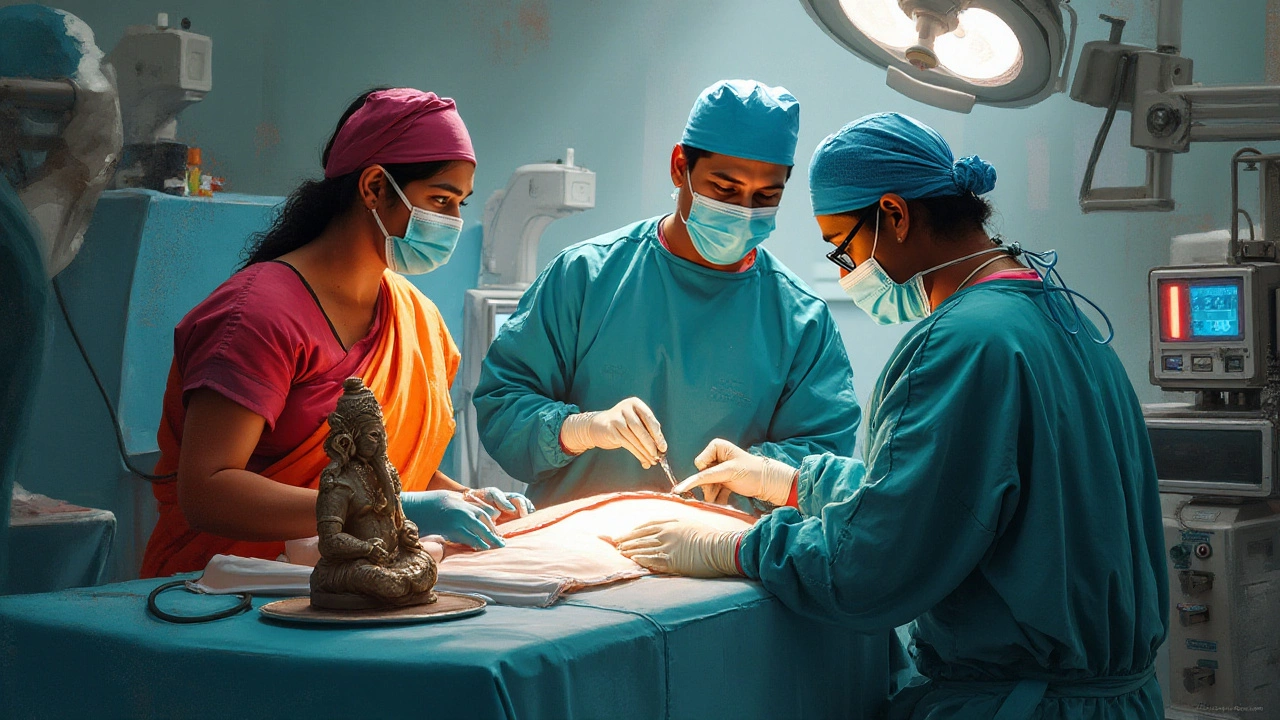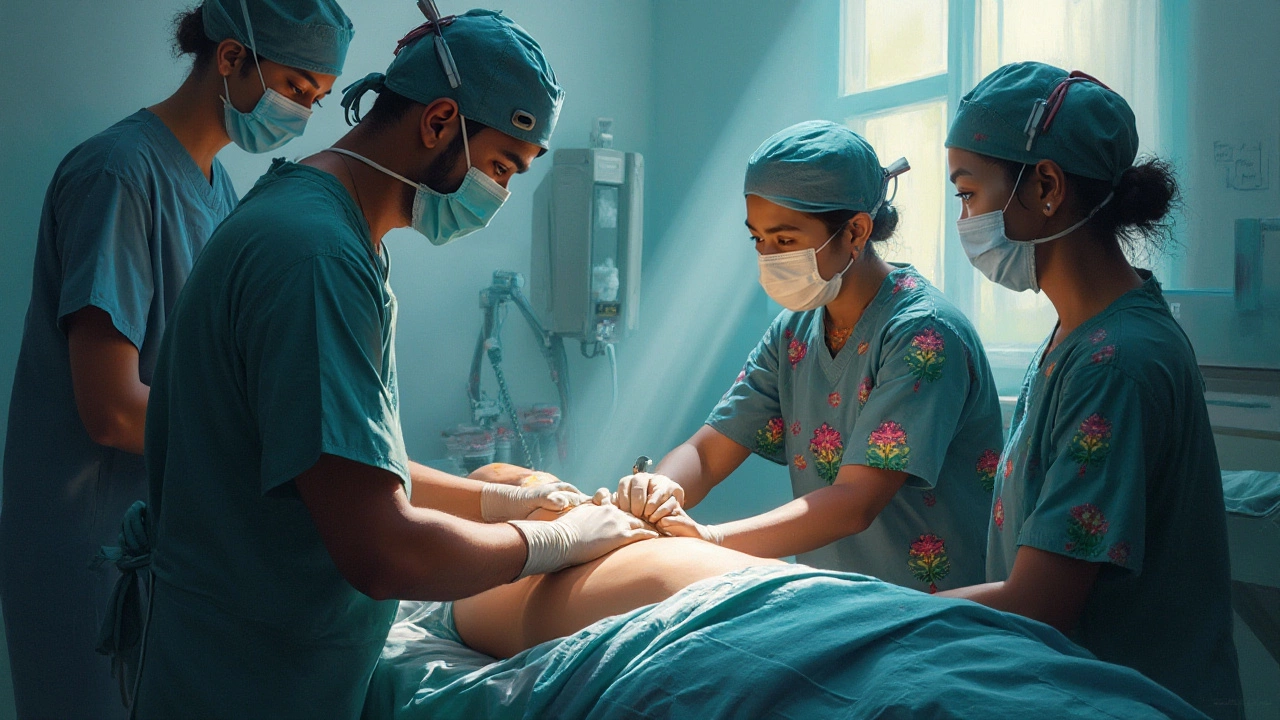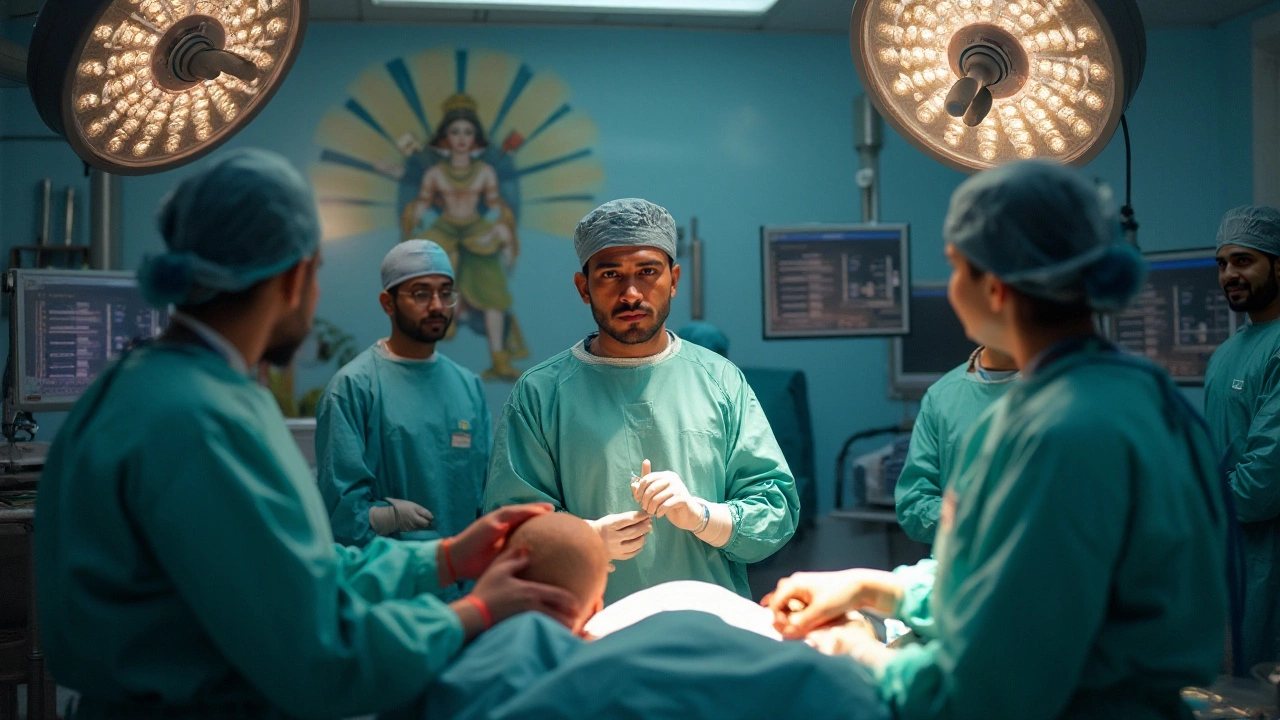In the sterile environment of an operating room, many life-saving miracles take place every day. Yet, the notion of a heart stopping during surgery can be unnerving. It's rare, but when it happens, it's a matter where seconds count. Understanding what happens when the heart takes an unexpected pause can help demystify the process and maybe even sprinkle in a bit of comfort.
During any surgery, the surgical team is hyper-vigilant, ready to tackle unexpected events like cardiac arrest with precision. They spring into action, employing a range of strategies - like CPR and advanced monitoring systems - to bring the patient's heart back to its rhythmic dance. It's nothing short of a choreographed performance, where every member of the team knows their role perfectly.
The action doesn’t stop there. The real heroes of the day are often the unsung ones - the anesthesiologists and support staff. They're armed not just with scalpels and stitches, but with knowledge, technology, and an unflinching focus on the patient's well-being from the moment they roll in.
- Understanding Cardiac Arrest in Surgery
- Immediate Actions by the Surgical Team
- The Role of Technology and Equipment
- The Importance of Anesthesiologist and Support Staff
- Post-Surgery Monitoring and Care
Understanding Cardiac Arrest in Surgery
During surgery, a patient's body undergoes various physiological changes due to anesthesia and the surgical procedure itself. One of the most serious events that can occur is a cardiac arrest, where the heart unexpectedly stops beating. This event is as dramatic as it sounds and requires immediate intervention.
What Triggers Cardiac Arrest?
Several factors can lead to a cardiac arrest during surgery. Often, it might result from complications such as excessive bleeding, a reaction to anesthetic drugs, or an underlying heart condition that was not previously identified. Surgeons and anesthesiologists assess these risks before the procedure to prevent such events as much as possible.
The Incidence Rates
It’s important to know that cardiac arrests in the surgical environment are fairly rare. According to the American Heart Association, the incidence is approximately 1 in every 10,000 non-cardiac surgeries. This does not mean it's not a significant risk, but the odds are reassuringly low due to modern advancements in surgical techniques and monitoring technologies.
| Type of Surgery | Incidence per 10,000 |
|---|---|
| Non-Cardiac Surgery | 1.0 |
| Cardiac Surgery | 7.8 |
| Major Trauma | 10.0 |
Biological Complexity
Understanding the biological underpinnings of a cardiac arrest involves recognizing the complexity of the human heart. The heart's electrical system malfunctions in an arrest, which disrupts the blood's journey through the body. This requires the immediate, coordinated rush of actions from the surgical team.
Once the heart stops, oxygenated blood is no longer delivered to the brain and other vital organs, making it crucial to restore circulation as soon as possible. This is where the expertise of the surgical team comes into play, equipped with the prowess to turn the tide in those critical moments.
The Need for Preparedness
Every surgery harbors risks, which is why meticulous preparation occurs before the patient even enters the operating room. Preoperative assessments aim to identify those at higher risk for medical emergencies like cardiac arrest, allowing for personalized strategies to mitigate those risks.
The better informed you are about potential risks and how they are managed, the more empowered you'll feel if surgery becomes a necessary step in your healthcare journey. By understanding what's going on behind the scenes, you'll appreciate not only the science but the skill involved in ensuring your safety.
Immediate Actions by the Surgical Team
When a patient's heart unexpectedly ceases its rhythmic beat during surgery, the surgical team is thrust into a life-saving ballet, each member performing a crucial step. The first response is always an immediate assessment to verify whether cardiac arrest is indeed occurring. The entire team's training and focus pivots instantly to this critical emergency.
Checking Vital Signs
The first action taken is to assess the patient's vital signs. This includes verifying whether there is a pulse and if the patient is breathing. Sometimes, the heart's electrical activity is monitored through electrocardiograms (ECG), giving the team a real-time picture of heart rhythm and rate.
Initiating CPR
If a pulse isn't detected, cardiopulmonary resuscitation (CPR) is immediately initiated. The surgeon or another trained member of the team begins chest compressions, ensuring that blood continues to flow to the brain and vital organs. CPR is a pivotal procedure that can often buy precious time while addressing the crisis.
Advanced Cardiac Life Support (ACLS)
Alongside CPR, the team may employ Advanced Cardiac Life Support (ACLS) protocols. This involves administering medications to stimulate the heart, such as epinephrine, and, if necessary, using a defibrillator to deliver a controlled electric shock to try and restore the heart's natural rhythm.
The Role of Anesthesia
The anesthesiologist monitors the patient's oxygenation and ventilation closely, ensuring the patient is receiving adequate oxygen. Often, medications that might have contributed to the arrest are reversed, helping the heart regain its function.
Quick and Effective Communication
Communication plays a critical role in successfully managing a cardiac crisis during heart surgery. The team communicates swiftly and effectively, ensuring everyone is aware of their role and the next steps. This synchrony can be the factor that turns a fatal situation into one with a hopeful outcome.
| Action | Time to Initiate |
|---|---|
| CPR | Within 1 minute |
| ACLS Protocols | Within 5 minutes |
It is this orchestrated effort, supported by continuous communication, that underscores the professionalism of the surgical team. These immediate actions do not just save lives; they enhance trust in the capabilities and preparedness of medical professionals handling such high-stakes situations.

The Role of Technology and Equipment
In the delicate world of heart surgery, technology and equipment aren't just accessories; they are lifelines. Advanced medical tools can mean the difference between a smooth recovery and unexpected complications. These technologies are not only pivotal in preventing cardiac arrest but also crucial in responding to it when it arises.
Monitoring Systems
From the moment a patient enters the operating room, an array of sophisticated monitoring devices closely tracks vital signs. These include electrocardiograms (ECGs) that provide real-time data on heart rhythm, blood pressure monitors, and oxygen saturation detectors. It's like having a personal guardian watching your every breath, heartbeat, and even the slightest deviation from normal can trigger immediate intervention.
Defibrillators
When the heart throws a tantrum and decides to stop, defibrillators step up as unsung heroes. This piece of equipment sends an electric shock to the heart to restore its natural rhythm. As stated by Dr. James Peterson, a renowned cardiac surgeon,
"Defibrillators have transformed what would be catastrophic events into manageable medical scenarios."The presence of automated external defibrillators (AEDs) in operating rooms brightens the prospects for patient survival and recovery.
Anesthesia Machines
While anesthesia machines primarily keep the patient unconscious and free of pain, they play double duty by ensuring the delivery of precise medication dosages, maintaining airway access, and monitoring vitals. This comprehensive oversight makes anesthesia a pivotal player in the operating room orchestra.
Support Equipment
Beyond the glitzy tech, even basic equipment like infusion pumps and ventilators hold invaluable roles. They ensure continuous fluid and medication administration and help patients breathe when the heart's pumping action wavers. All in all, each piece of equipment, no matter how simple, forms a part of a complex safety net designed to support cardiac health.
During surgeries, the blend of human expertise, attentiveness, and cutting-edge technology creates an environment where unexpected medical emergency events like cardiac arrest can be addressed efficiently, with grace and precision. That harmony offers hope, reassures the worried minds, and underscores the relentless pursuit of patient safety in modern medicine.
The Importance of Anesthesiologist and Support Staff
In the high-stakes realm of surgery, while the surgeon undoubtedly takes center stage, it's the anesthesiologist and support staff who orchestrate the critical aspects behind the scenes. Their influence and expertise are pivotal, often making the crucial difference between life and death when a medical emergency such as cardiac arrest occurs.
Behind the Mask: Role of the Anesthesiologist
At the heart of the operating room's vigilance is the anesthesiologist. More than just administering anesthesia, they keep a close watch on every heartbeat, ensuring that the patient's vital signs remain stable throughout the procedure. This expert takes responsibility for adjusting anesthesia levels, managing pain, and even executing advanced life-saving interventions when necessary.
If the heart stops, the anesthesiologist immediately steps into action. They are adept at performing or directing cardiopulmonary resuscitation (CPR) and can rapidly administer life-sustaining medications. Their training and instincts enable them to quickly assess and rectify the situation, often even before it's noticeable to the untrained eye.
The Dynamic Role of the Support Staff
The orchestra of surgery wouldn't function without a competent support staff. These skilled nurses, technicians, and assistants are crucial in ensuring that the surgeons and anesthesiologists have everything they need to perform their jobs efficiently. They handle the equipment, keep the environment sterile, and prepare the operating room setup beforehand.
During an emergency, support staff act as the extra pairs of hands and eyes. They are essential in managing equipment such as defibrillators, assisting in CPR, and generally ensuring that a chaotic situation is kept under control. Their calm demeanor and quick thinking can be critical in ensuring that the operating room remains a place of order rather than panic.
The Human Factor: Experience and Trust
Experience counts. Many anesthesiologists and support staff have faced unexpected events during their careers, and each encounter hones their ability to respond effectively. Hospitals often hold simulations and training sessions to ensure preparedness for various scenarios, reinforcing protocols and enhancing teamwork.
Trust also plays a vital role. The synergy between surgeons, anesthesiologists, and support staff is built on mutual respect and understanding. This trust ensures that communication is seamless, actions are cohesive, and patient care is the utmost priority.
As we delve deeper into the complex world of surgery, one realizes that it is truly a collaborative effort. The importance of an anesthesiologist and support staff cannot be understated, especially when the heart — quite literally — hangs in the balance.

Post-Surgery Monitoring and Care
Emerging from the haze of anesthesia, the patient embarks on the crucial phase of post-surgery monitoring and care. This period is vital for ensuring that the heart regains and maintains its normal rhythm and function after the strains of surgery. As the heart stabilizes, the potential for complications requires vigilant observation by medical staff, who are trained to detect even the subtlest of irregularities.
Continuous Monitoring for Optimal Recovery
Once moved from the operating room, the patient often enters an Intensive Care Unit (ICU) or recovery area, where innovations in medical technology come to the forefront. Here, continuous cardiac monitoring using advanced telemetry systems gives real-time updates on heart rate, oxygen levels, and blood pressure. Each beep and blip on the monitor serves as a guide for healthcare professionals to adjust treatment promptly.
A 2023 study by the American Heart Association found that continuous monitoring substantially decreases the risk of post-operative cardiac events, bolstering patient survival rates. This not only emphasizes the importance of technology but also highlights the need for skilled observance by the medical team.
The Action Plan: Tailored and Precise
Post-surgical care isn't a one-size-fits-all solution. Instead, it's a finely-tuned approach tailored to individual needs. Here's what typically unfolds:
- Immediate pain management and comfort assessment to ensure the patient is stable and as pain-free as possible.
- Regular blood work to assess for signs of infection or adverse responses to surgery.
- Nutritional support, often starting with intravenous fluids, transitioning to solid food as the patient gains strength.
- Rehabilitation plans initiated to promote movement and prevent complications like blood clots.
Continuity of Care: Beyond the Hospital Walls
Once the medical team is satisfied with the patient's recovery trajectory, plans for discharge begin to take shape. But the care doesn't end at the hospital exit. Continuing care involves:
- Scheduled follow-up appointments to monitor cardiac health and adjustments in medications if necessary.
- Prescribed cardiac rehabilitation programs designed to rebuild strength and endurance safely.
- Education on lifestyle modifications that reduce the risk of future cardiac events, focusing on diet, exercise, and stress management.
A heart-stopping moment in the operating room transforms into a collaborative effort for healing and recovery. It's a testament to the resilience of the human body and the dedication of the medical team.
